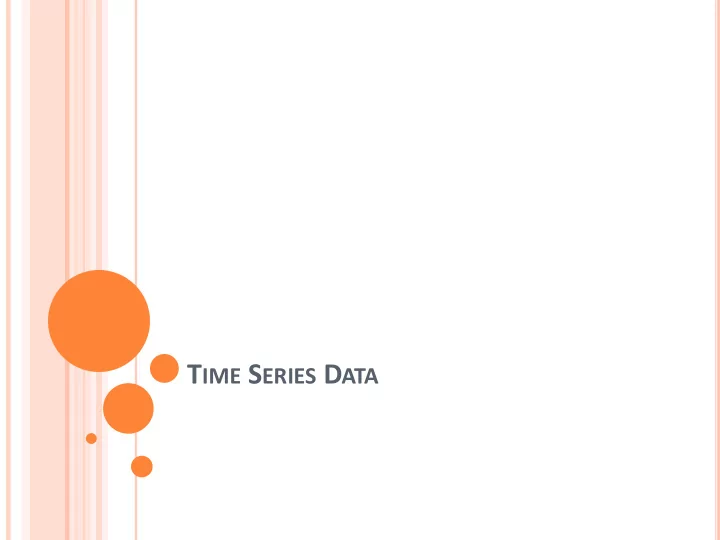

T IME S ERIES D ATA
P APERS C OVERED Interactive Visualization of Serial Periodic Data John V. Carlis and Joseph A. Konstan Visualizing and Discovering Non-Trivial Patterns in Large Time Series Databases Jessica Lin, Eamonn Keogh, Stefano Lonardi Time-series Bitmaps: A Practical Visualization Tool for working with Large Time Series Nitin Kumar, Nishanth Lolla, Eamonn Keogh, Stefano Lonardi, Chotirat Ann Ratanamahatana
W HAT IS TIME SERIES D ATA ?
W HAT IS TIME SERIES D ATA ? A value over time
W HAT IS TIME SERIES D ATA ? A value over time not too useful A sequence of time point + value pairs < t 0 , v 0 > < t 1 , v 1 > < t 2 , v 2 > … < t n , v n >
W HAT IS TIME SERIES DATA ? t i ≤ t i+1 not t i < t i+1 Low resolution of time Errors Discontinuities Multiple sources of measurement
W HAT IS TIME SERIES DATA ? common examples: financial data electrocardiograms meteorological data production rates …
W HAT IS TIME SERIES DATA ? Doesn’t need to be a numerical value over time routes position over time schedules Activity over time (resource focused) resource over time (activity focused)
T ASKS WITH TIME SERIES DATA Finding patterns periodic vs non-periodic finding known patterns searching sequence matching classification finding common unknown patterns motif discovery clustering finding rare patterns anomaly detection
T ASKS WITH TIME SERIES DATA Finding trends general increasing/decreasing abrupt changes anomaly detection correlation between variables
P APER 1 Interactive Visualization of Serial Periodic Data John V. Carlis and Joseph A. Konstan
P ERIODIC D ATA “Pure” periodic data each period has identical duration vs event anchored periodic data periods start following some event time between events may be inconsistent Focus is on pure periodic data
P ERIODIC D ATA Initial Approach: Calendars (tabular layouts) Cluster and Calendar based Visualization of Time Series Data. Jarke J. van Wijk and Edward R. van Selow, Proc InfoVis 99
P ERIODIC D ATA Calendar (tabular) layouts exaggerate distance between adjacent periods
P ERIODIC D ATA Calendar (tabular) layouts exaggerate distance between adjacent periods Solution: layout the series in a spiral
P ERIODIC D ATA The end of one period is close to the start of the next. Encodes time with two visual attributes distance from center is time angle is time relative to start of period Values at time points must be encoded some other way same with tabular layouts
P ERIODIC D ATA dot size line width
P ERIODIC D ATA glyph
P ERIODIC D ATA Interaction manually adjust period length
P ERIODIC D ATA Interaction change point of view (for 3D spirals)
P ERIODIC D ATA good: space efficient neighbouring points are always near each other easy to tell where a point is within a period bad: points within the same period may be very far apart inconsistent density can‘t display many variables glyph occlusion bewildering 3D views
P APER 2 & 3 Visualizing and Discovering Non-Trivial Patterns in Large Time Series Databases Jessica Lin, Eamonn Keogh, Stefano Lonardi Time-series Bitmaps: A Practical Visualization Tool for working with Large Time Series Nitin Kumar, Nishanth Lolla, Eamonn Keogh, Stefano Lonardi, Chotirat Ann Ratanamahatana
P ATTERN D ETECTION Observation: sequence matching and pattern detection is a lot easier for strings Symbolic Aggregate approXimation (SAX) dimensionality reduction
P ATTERN D ETECTION - SAX From initial time series…
P ATTERN D ETECTION - SAX First step, discretize time into w equal sized intervals aggregate the points within each interval (ie, average)
P ATTERN D ETECTION - SAX Second step, discretize the value for each interval into an alphabet of size α should result in equiprobable symbols
P ATTERN D ETECTION - SAX Linear trends could make patterns meaningless Could get patterns like aaaaabbbbbbccccc. Use a short sliding time window symbols are equiprobable within the time window produces a set of strings instead of just one
P ATTERN D ETECTION – V IZ T REE VizTree Idea: The set of strings produced by SAX can be encoded as a suffix tree Using a time window of length, 2 cbabbbaaacc becomes {cb, ba, bb, bb, ba, aa, ac, cc}
P ATTERN D ETECTION – V IZ T REE Increase edge width paths containing large # of matching sequences Frequent patterns and anomalies are easily recognizable
P ATTERN D ETECTION – T IME S ERIES B ITMAPS Instead of using node-link diagrams to represent a suffix tree we can create a treemap encode # of matches as colour of each cell Restrict # of cells to a small value (~16)
P ATTERN D ETECTION – T IME S ERIES B ITMAPS Very difficult to interpret what a sequence looks like from the map No good for analyzing an individual time series Easy/quick to compare different time series, useful for overviews of many time series spotting clusters & anomalies
P ATTERN D ETECTION Good: Fast method for approximating time series as symbolic strings Easy to see common/uncommon subsequences with suffix trees Easy to compare multiple time series with bitmaps Bad: unclear how to determine key parameters; (1) length of sliding window, (2) # of intervals to use, (3) alphabet size
Recommend
More recommend